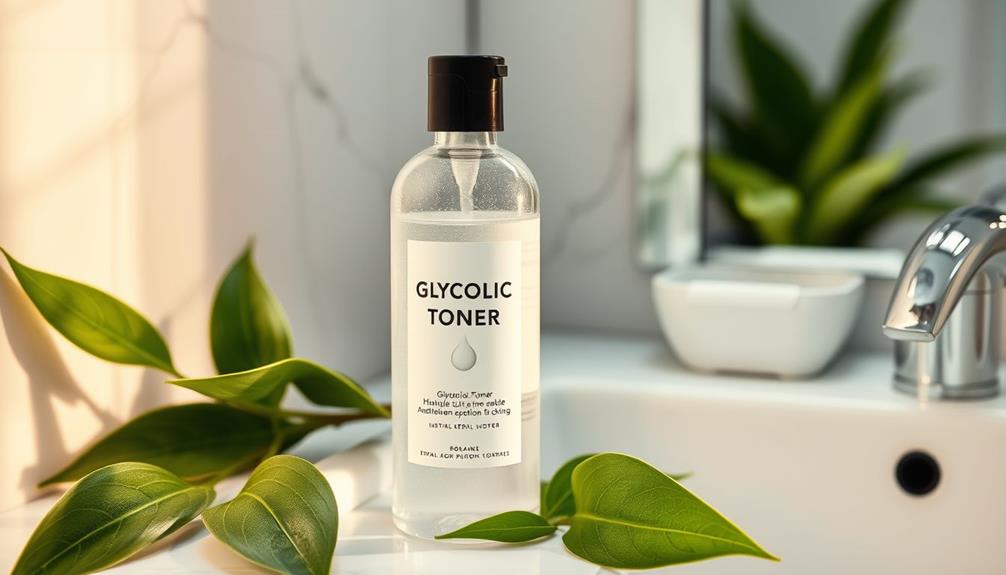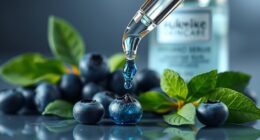Glycolic acid is a powerful exfoliant that'll revolutionize your skincare routine. It works by dissolving dead skin cells, revealing a brighter and smoother complexion. You'll notice reduced fine lines, even skin tone, and fewer breakouts. This alpha hydroxy acid boosts hydration and stimulates collagen production, making your skin look youthful and radiant. Start slow by using it once a week, then gradually increase as your skin adjusts. Just remember, applying sunscreen daily is essential, as glycolic acid can increase sun sensitivity. Want to explore its full potential and find the best products for your skin?
Key Takeaways
- Glycolic acid is a powerful exfoliant that helps reveal a brighter complexion by dissolving dead skin cells.
- It reduces fine lines and wrinkles, promoting a more youthful appearance and improved skin firmness.
- The acid targets dark spots, resulting in a more even skin tone and enhanced radiance.
- Glycolic acid unclogs pores, effectively reducing acne breakouts and inflammation for clearer skin.
What Is Glycolic Acid?
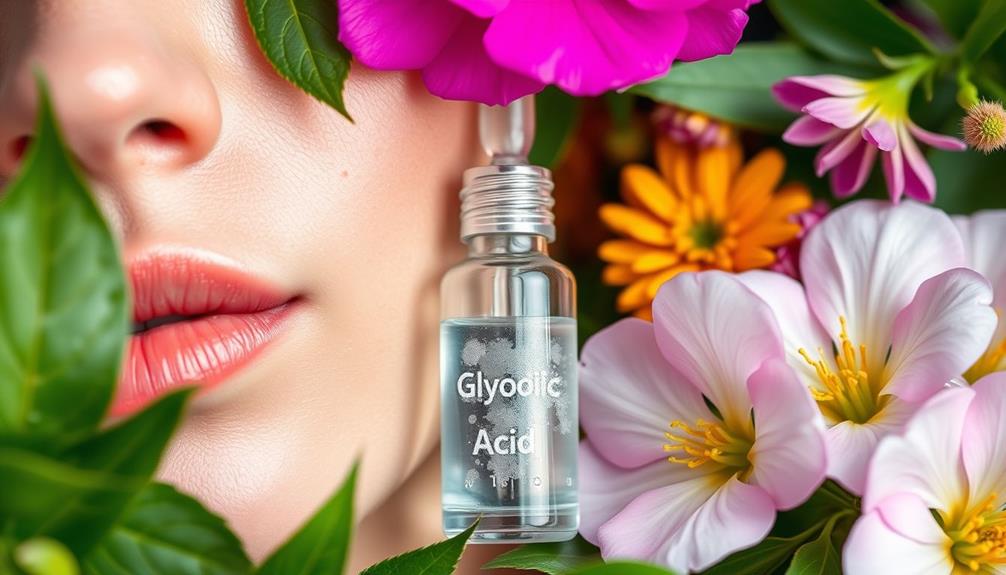
Glycolic acid is a powerful exfoliant derived from sugar cane that effectively rejuvenates your skin. As a water-soluble alpha hydroxy acid (AHA), it stands out due to its small molecular size, allowing it to penetrate deeply into the skin. This deep penetration helps glycolic acid exfoliate by dissolving dead skin cells, promoting faster cell turnover.
Notably, incorporating natural ingredients, such as essential oils, can complement the effects of glycolic acid, enhancing your overall skincare routine. By utilizing essential oils for skin health, you can further boost hydration and nourishment for your complexion.
Regular use of glycolic acid can help you achieve a smoother, more radiant complexion. It not only works to remove dead skin cells but also enhances hydration levels. Acting as a humectant, glycolic acid attracts moisture, ensuring your skin stays plump and hydrated.
You'll find this powerful ingredient in various skincare products, from serums to cleansers and masks, making it easy to integrate into your routine.
If you're looking for a solution to dull skin, dark spots, or fine lines, glycolic acid is an excellent choice. By choosing the right products, you can harness its benefits and transform your skin's appearance.
Key Benefits for Your Skin

By incorporating glycolic acid into your skincare routine, you can release a range of key benefits that enhance your skin's appearance and health. One of the primary benefits of glycolic acid is its ability to exfoliate dead skin cells, promoting cell turnover and revealing a brighter, more radiant complexion.
Regular use can greatly reduce the appearance of fine lines and wrinkles, helping you achieve younger-looking skin through improved elasticity and firmness. Additionally, integrating gentle yoga stretches before bedtime can further support your skincare efforts by promoting relaxation and stress relief, which are essential for healthy skin.
Glycolic acid also targets dark spots and uneven skin tone by breaking down pigmentation and promoting a more uniform complexion. This powerful exfoliant unclogs pores, reducing acne breakouts and preventing the accumulation of dead skin cells that can lead to inflammation.
Moreover, glycolic acid's humectant properties draw moisture to your skin, boosting hydration levels and enhancing overall texture and radiance. By addressing multiple skin concerns, including aging, pigmentation, and acne, glycolic acid provides a thorough solution for anyone seeking healthier, more vibrant skin.
Embracing these benefits can transform your skincare routine and help you achieve the glowing complexion you desire.
How Glycolic Acid Works
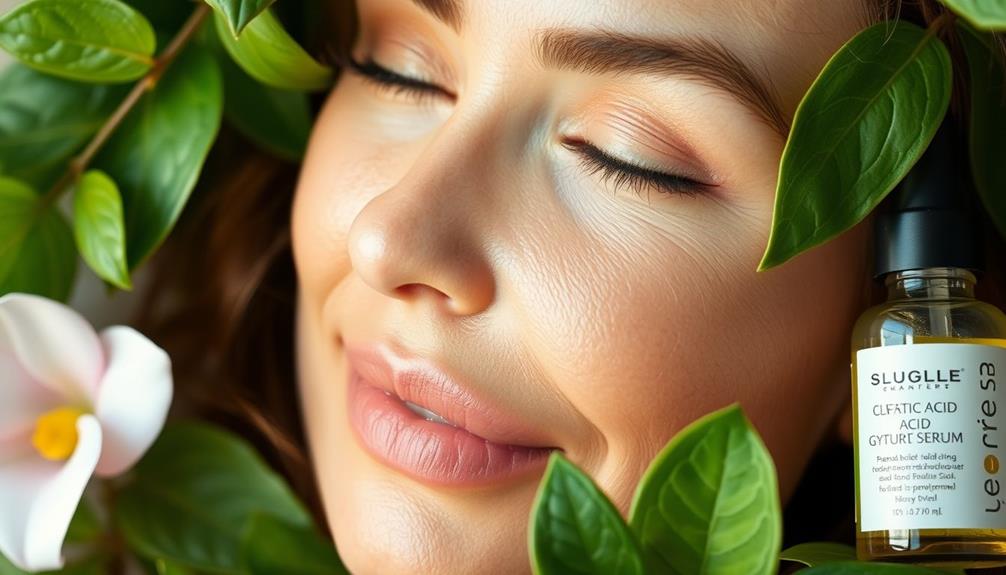
Understanding how glycolic acid works reveals its remarkable ability to transform your skin through effective exfoliation and hydration. This powerhouse ingredient breaks down the bonds between dead skin cells on the epidermis, promoting their removal and revealing fresher skin underneath. Its small molecular size allows glycolic acid to penetrate deeply, enhancing both exfoliation and rejuvenation.
Additionally, incorporating gentle skincare practices can further support your skin's health, such as avoiding irritants like citrus scents that can adversely affect sensitive skin.
Here are four key ways glycolic acid benefits your skin:
- Exfoliation: By removing dead cells, glycolic acid helps improve your skin's overall texture and tone.
- Collagen Production: It stimulates the production of collagen, which supports firmness and elasticity for a smoother appearance.
- Enhanced Hydration: Acting as a humectant, glycolic acid attracts moisture to your skin, boosting natural hydration factors.
- New Cell Production: It encourages the generation of new skin cells from the lower layers, reducing the buildup of dead cells.
Recommended Usage Guidelines

Using glycolic acid effectively requires following specific guidelines to maximize its benefits while minimizing potential irritation. Start using glycolic acid 1-2 times a week and gradually increase to 2-3 times based on your skin's tolerance. If you have sensitive skin, take a slower approach. Always apply glycolic acid products in the evening, allowing your skin to recover overnight.
Here's a simple guide to help you:
| Step | Action | Notes |
|---|---|---|
| 1. Patch Test | Apply glycolic acid on a small area | Check for irritation |
| 2. Frequency | Start 1-2 times a week | Increase as tolerated |
| 3. Time of Day | Apply glycolic acid in the evening | Avoid daytime use unless stated |
| 4. Post-Application Care | Use hydrating products | Replenish moisture |
| 5. Sun Protection | Apply sunscreen daily | Counteract sun sensitivity |
Following these guidelines guarantees a safe and effective exfoliation process. Remember, consistency is key, and your skin will thank you for it!
Potential Side Effects
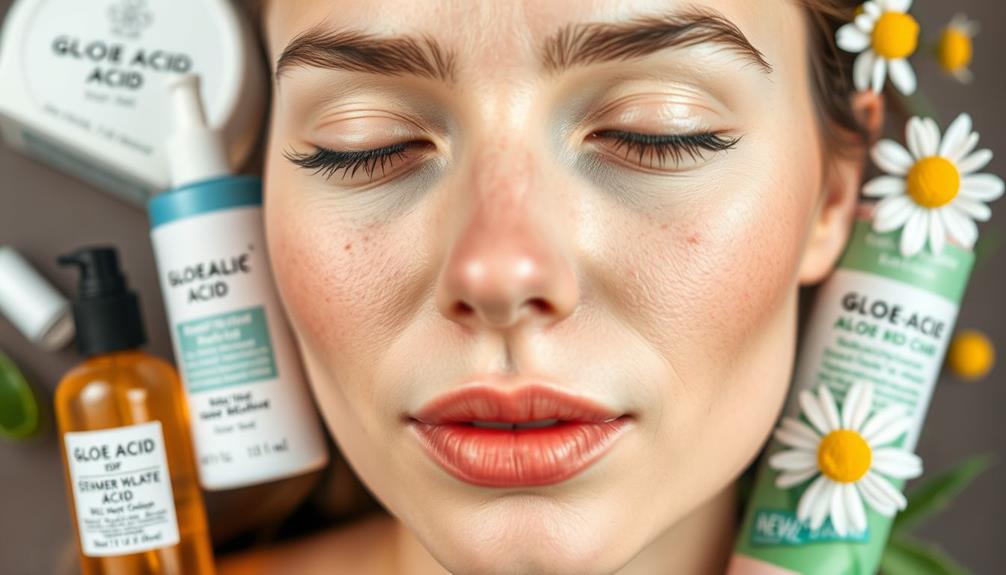
Glycolic acid can cause side effects like redness, irritation, and peeling, particularly for those with sensitive skin or when overused. Understanding these potential side effects is vital for anyone considering adding glycolic acid to their skincare routine. Here are some key points to keep in mind:
- Redness and Irritation: You may experience initial skin irritation, especially if you're new to glycolic acid. Gradually introducing it can help minimize these effects. Additionally, just as with essential oils in <a target="_blank" href="https://aromatherapynaturals.com">aromatherapy techniques</a>, you should be cautious with application and monitor your skin's reactions.
- Skin's pH Balance: Overusing glycolic acid can disrupt your skin's pH balance, leading to increased irritation and sensitivity over time.
- Patch Test: Always perform a patch test before applying glycolic acid to larger areas of your face. This step can help you avoid adverse reactions.
- Increased Sun Sensitivity: Be aware that glycolic acid can increase your skin sensitivity to the sun, making it critical to monitor your skin reactions and adjust usage accordingly.
Importance of Sunscreen

Daily sunscreen application is a must when incorporating glycolic acid into your skincare routine, as it greatly increases your skin's sensitivity to the sun.
Using glycolic acid can enhance your skin's exfoliation process, but it also means your skin barrier is more vulnerable to UV damage. To combat this, choose a broad-spectrum sunscreen with an SPF of 30 or higher. This protects your skin from both UVA and UVB rays, essential for preventing further hyperpigmentation and skin aging caused by sun exposure.
Make it a habit to apply sunscreen every morning, even on cloudy days, since up to 80% of UV rays can penetrate through clouds. This daily practice helps maintain the benefits you've gained from glycolic acid treatments.
Additionally, consider wearing protective clothing and seeking shade during peak sun hours to further enhance your skin's defense against harmful rays.
Natural Vs. Synthetic Glycolic Acid

Natural glycolic acid often offers a gentler and more effective alternative to its synthetic counterparts, thanks to its plant-derived origins. When evaluating your skincare options, understanding the differences can help you choose the best for your skin type.
Here are some key points to reflect upon:
- Plant Sources: Natural glycolic acid is derived from sugar cane and fruits, providing additional beneficial compounds that enhance hydration and nourishment.
- Skin Benefits: Products with natural glycolic acid often outperform synthetic ones regarding absorption and overall efficacy, promoting healthier skin.
- Exfoliating Properties: The chemical structure of natural glycolic acid allows for deeper penetration into the skin, maximizing its exfoliating properties.
- Irritation: Natural options generally minimize the risk of irritation, making them suitable for a wider range of skin types, including sensitive skin.
Best Products With Glycolic Acid
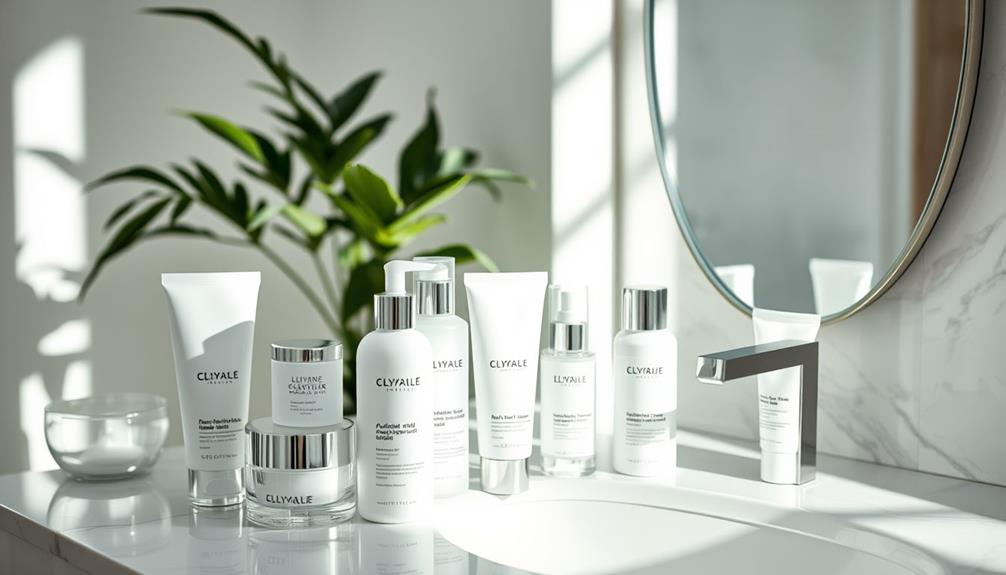
Choosing the right product with glycolic acid can greatly enhance your skincare routine, offering a range of benefits from exfoliation to improved skin texture.
For effective exfoliating the skin, consider the Face Sculpt Serum by Nina Bal. With a low concentration of glycolic acid, 75% of testers reported younger-looking, glowing skin within just two weeks.
If you're looking for a powerful over-the-counter product, Alpha-H's Liquid Gold provides one-step exfoliation that delivers smoother and clearer skin thanks to its low pH formulation.
Eight Saints offers glycolic acid products like Soulmate and Bright Side, designed to minimize irritation while still delivering potent results.
If you're concerned about age spots or existing acne, L'Oréal Paris Revitalift lines incorporate glycolic acid with hydrating ingredients, addressing fine lines and uneven skin tone effectively.
Ultimately, for overnight rejuvenation, try The Beauty Sleep Power Peel, a night mask that combines glycolic acid with age-defying benefits.
Combining With Other Ingredients
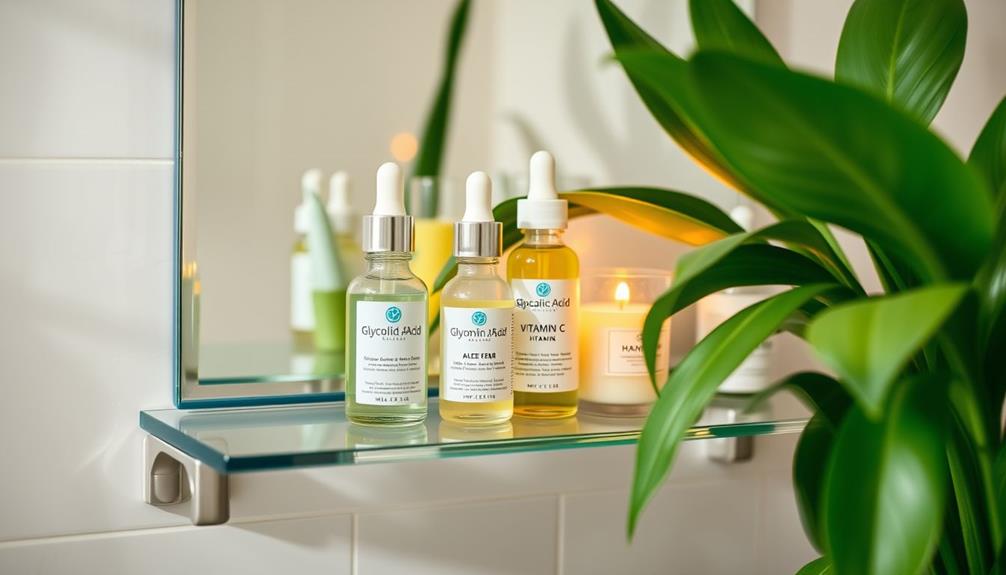
When combining glycolic acid with other ingredients, you'll enhance its benefits while minimizing potential irritation. By carefully selecting complementary active ingredients, you can create a balanced skincare routine that maximizes results.
Here are four effective combinations:
- Glycolic Acid + Vitamin C: This duo works synergistically to exfoliate and brighten your complexion, enhancing skin radiance and overall brightness.
- Glycolic Acid + Hyaluronic Acid: Pairing these two helps counteract any dryness from glycolic acid. Hyaluronic acid provides essential moisture, keeping your skin hydrated and plump.
- Glycolic Acid + Niacinamide: This combination is beneficial as niacinamide soothes the skin and minimizes redness, balancing the exfoliating effects of glycolic acid while enhancing your skin's barrier.
- Glycolic Acid + Retinol: While both are powerful, it's best to avoid using them together in the same routine to prevent irritation. Instead, alternate their use for peak results.
Always check product labels for compatibility when mixing glycolic acid with other active ingredients. With the right combinations, you can create a skincare routine that exfoliates effectively while maintaining moisture and minimizing irritation.
Tips for Sensitive Skin

If you've got sensitive skin, it's important to start slow and gradually increase your glycolic acid usage.
Always patch test a small area before applying it to your face, as this helps you spot any adverse reactions.
After using glycolic acid, make sure to hydrate your skin to keep it calm and healthy.
Start Slow and Gradually
Start with a low concentration glycolic acid product, applying it just once a week to see how your skin reacts. This method helps you start slow and gradually incorporate glycolic acid into your skincare routine while evaluating your skin's tolerance. Pay close attention to how your skin responds, looking for any signs of irritation.
Here are some tips to follow:
- Increase Frequency: After a few weeks, if your skin tolerates it well, increase usage to 2-3 times a week.
- Monitor Reactions: Always watch for signs of irritation, such as redness or peeling. If these occur, reduce the frequency again.
- Use a Gentle Moisturizer: After applying glycolic acid, use a gentle, hydrating moisturizer to soothe your skin and help prevent dryness.
- Apply Sunscreen: Always wear a broad-spectrum sunscreen during the day, as glycolic acid can increase your skin's sensitivity to the sun.
Patch Test Always
Before diving into glycolic acid treatments, always conduct a patch test to make sure your skin can handle it without adverse reactions. This step is especially vital if you have sensitive skin or existing skin conditions.
To perform a patch test, apply a small amount of the glycolic acid product on a discreet area, such as behind your ear or on your inner forearm. Monitor the area for any signs of irritation, redness, or discomfort over the next 24-48 hours.
If you don't experience any negative reactions, you can start incorporating glycolic acid into your skincare routine. Begin with low concentrations to gauge your skin's tolerance.
For those with sensitive skin, opt for glycolic acid products that feature gentle formulations with lower pH levels to minimize irritation.
If you notice persistent irritation or have concerns about using glycolic acid, especially when layering with other actives, consult with a dermatologist for personalized advice.
Prioritizing a patch test guarantees that you can enjoy the benefits of glycolic acid without compromising your skin's health.
Hydrate Post-Application
After you've applied glycolic acid, hydrating your skin becomes important to restore moisture and soothe any potential irritation. Here are some tips for your post-application routine, especially if you have sensitive skin:
- Choose a Gentle Moisturizer: Opt for a fragrance-free moisturizer containing hyaluronic acid to help calm irritation and enhance moisture retention without causing further sensitivity.
- Incorporate a Hydrating Serum: Look for serums with glycerin or other hydrating ingredients. They can absorb into the skin effectively and provide an extra layer of moisture.
- Add Soothing Ingredients: Incorporate calming elements like aloe vera or chamomile to help soothe the skin and reduce redness after glycolic acid application.
- Allow Proper Absorption: Always wait a few minutes to let the glycolic acid fully absorb into the skin before applying your hydrating product. This maximizes the effectiveness of both the exfoliant and moisturizer.
Conclusion
Incorporating glycolic acid into your skincare routine can be a game changer for your skin.
With its powerful exfoliating properties and ability to reveal a radiant complexion, it's like turning back the clock on your skin.
Remember to start slow, listen to your skin, and combine it wisely with other ingredients for the best results.
Embrace the journey to smoother, brighter skin—your face will thank you for it!



